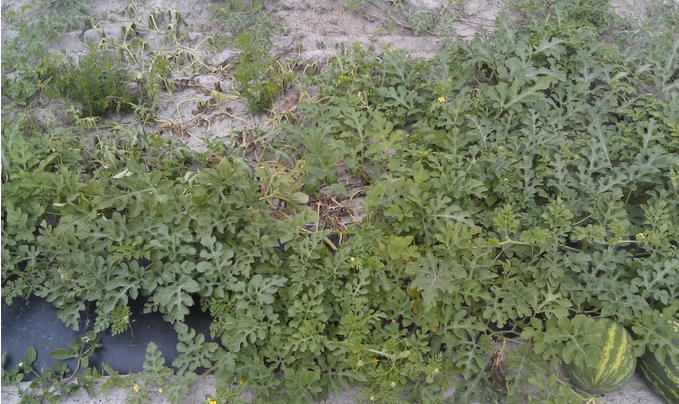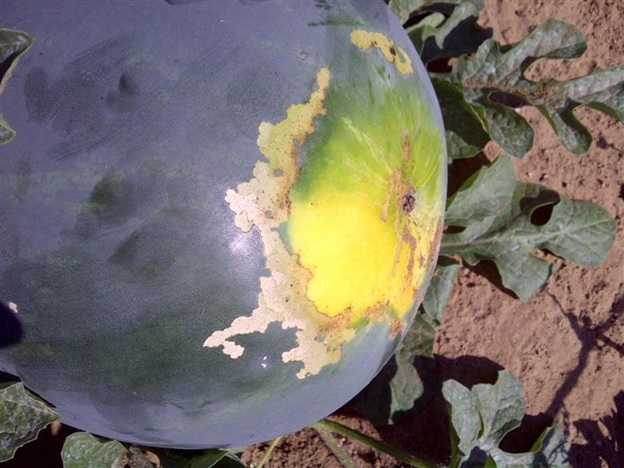UF/IFAS Extension Suwannee Valley Weekly Watermelon Crop Update. Summarized by Bob Hochmuth with input from Suwannee Valley Extension Agents: Mark Warren, Tyler Pittman, Tatiana Sanchez, Luke Harlow, Jay Capasso, Sylvia Wills, Dan Fenneman, Keith Wynn, Danielle Sprague, Kevin Athearn, and Charles Barrett.
–
Nutrient and Irrigation Management Update
The last week in April proved to be the week of dramatic changes in water and nutrient uptake in the earliest planted crops. We began seeing a sharp increase in water uptake and the expected decline in petiole sap levels of nitrogen, in particular. This drop in nitrogen levels was anticipated, and was not a cause for alarm, unless petiole sap levels of nitrogen were exceptionally low (less than 300-400 ppm nitrate-N). Potassium levels generally were maintained at sufficient levels. As the crop sets and sizes fruit, the plants “pull hard” on the nitrogen and potassium levels within the plant. It is at this point in the season that we also begin to see differences in the sap nitrogen levels between seedless and seeded watermelons. In a normal crop, the sap levels tend to be slightly lower in seedless versus seeded watermelons right next to each other. Research conducted at NFREC-Suwannee Valley a few years ago documented this difference. Early in the season, the sap nitrogen levels are expected to be the same in seedless and seeded watermelon. But, after the crop is set and sizing, the sap concentrations begin to separate somewhat. Once the fruit is 2-inches, the nitrogen levels (ppm nitrate-N) in the sap will begin to separate, (seeded= 1,000-1,200 ppm, and seedless = 900-1,100 ppm). When fruit are one-half mature, perhaps 5 lbs per fruit, expect sap levels (nitrate-N) to be 800-1,000 for seeded varieties, and 600-800 for seedless varieties. At first harvest, expected sap levels (nitrate-N) for seeded varieties will be 600-800 ppm, and for seedless varieties will be 400-600 ppm. So, we have begun to see this separation and it is important to select leaves from only seedless varieties for testing petiole sap. One other important note, we did not see this same trend in dried whole leaf analysis results, only in petiole sap.
Just as a point of reference, most conventionally fertilized fields are at the stage of growth where the fertigation rates likely should be at 2.5 lbs. (at least 2 for any very young fields just setting fruit)) per acre per day rate for nitrogen and potassium, using the net acres of watermelons in the field (not including drive middles and other non-cropped areas in the field). Some growers inject every day and others 2-3 times weekly. The math should be calculated on a weekly basis. For a 2.5 lbs per acre per day rate times 7 days equals 17.5 lbs over that week. Once we start harvests, it is common to set the rate at 2 lbs per acre per day and leave it there until one week from last pick. This amount can be fine-tuned with the use of our petiole-sap testing program offered as a service by Extension agents in this region. Just a small side note, agents collectively in the Suwannee Valley area, last week tested at least 100 petiole-sap samples.
Water demands this past week escalated with heavy fruit setting and sizing of the fruit. This is always anticipated, and the change is dramatic. This generally happens in late April or early May depending on the season. Well, IT IS HAPPENING NOW! The warm temperatures last week, along with relatively low humidity and gentle breezy conditions, all added to the high evapotranspiration levels, and resulting high demand for water in the plant. I suspect, most fields are passing or already past the point when one irrigation event per day will do the job. Hopefully, every farm has soil moisture sensors, and are using them to guide the number and duration of each event. At this time, we have less concern about leaching and more concern about properly timed and sufficient events daily. Early in the season, we were much more concerned about too much water and risk of leaching events. Now, the concern will be keeping up with the demand. (summary by Bob Hochmuth)
–
Disease Update

Early wilting symptoms starting on one side of the plant for the disease Fusarium wilt of watermelon.
–
Reports last week were pretty similar to the previous 2 weeks in that we all see Fusarium wilt to be very active across the region with many reports of significant plant loss. This year’s dramatic increase in Fusarium cases is quite concerning and undoubtedly will trigger consideration of future changes to manage this disease.
We are seeing isolated cases of a few foliar diseases. The progress of Pseudomonas bacterial leaf spot seems to have slowed due to the dry weather conditions this past week. We are seeing activity in a few fields from Alternaria leaf spot and gummy stem blight. These are not widespread at all, so we are not suggesting general sprays across the region, but where gummy stem blight is found, we suggest a targeted fungicide.
We still expect to see more foliar diseases this week, so let your county agent know if you see new disease symptoms. One of our biggest concerns right now is powdery mildew, and this weather to me, just “feels like” powdery mildew conditions. I sure hope everyone has started a preventative program for powdery mildew by now. If not, I highly urge you to do so! We had suggested Miravis Prime if no symptoms are present yet, or adding Quintec, or Procure to the mix with mancozeb. Both Quintec and Procure had decent activity last year, but both also performed poorly last year in certain fields. The other disease we are keeping an eye out for is the arrival of downy mildew. We do not have a confirmation yet of downy mildew on watermelons in the Suwannee Valley, but we will not be surprised to see that soon. If we get confirmation in the area, we will be suggesting Ranman or Orondis Ultra. The closest confirmation of downy on watermelon is Hillsborough County. Keep in mind, we are only 2-3 weeks from being in the early harvest season, so make sure you keep up with your fungicide plans. (Summary by Bob Hochmuth with input from specialists, county agents, and consultants in the field)
–
Rindworm Reminder
–
We have not received reports of rindworms yet, but keep a close eye on any feeding damage and let us know if you see any early feeding symptoms. Management strategies are much more complicated now due to new label restrictions to protect pollinators (this is a good thing). Once you begin to see symptoms of damage, the better materials will include the higher labeled rates of Intrepid or Coragen (as a spray only), which are also safe for pollinators. Do not use pyrethroids (bifenthrin, Asana, Lambda, etc.) for control of rindworms, as there is a very high level of resistance to that class and they are very toxic to bees. I can only say, it is much easier to prevent rindworms than to clean them up once they start.
–
Thank You to the Suwannee Valley Rapid Diagnostic Watermelon Program and Its Industry Sponsors
UF/IFAS Extension agents have initiated a more formal way to support our watermelon growers with a rapid diagnostics system through Suwannee Valley Regional. This industry-funded program allows Extension Agents to submit and pay for watermelon grower plant disease and other diagnostic samples. This SV Rapid Diagnostic Watermelon Program will help us to get quicker diagnostic results and not have to charge the growers directly. Plant disease samples are typically $40 and leaf tissue analyses are typically $20. We want to thank the initial sponsors of this program: Syngenta Crop Protection, Harrell’s Fertilizer, Koppert Biological Systems, SEEDWAY LLC, BASF Vegetable Seeds, Bayer Crop Science, Gowan Seed, and Gowan USA for sponsoring this effort. Other industry reps interested in sponsoring this effort can contact Bob Hochmuth at bobhoch@ufl.edu or 386-288-6301.
- 2024 Watermelon Season Wrap Up - June 21, 2024
- Weekly Watermelon Update – June 3 - June 7, 2024
- Weekly Watermelon Update #10 – May 20 - May 24, 2024

